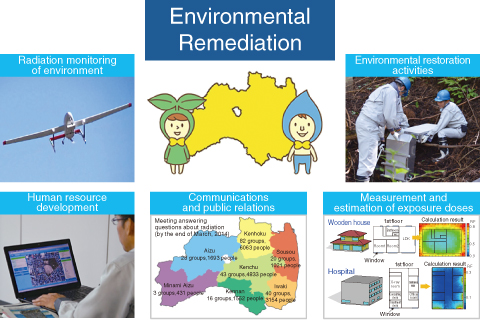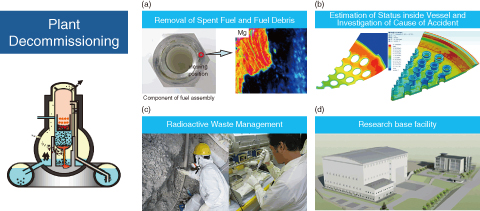
Fig.1-1 JAEA’s post-accident efforts at environmental remediation for the recovery of Fukushima
These activities are introduced on the web page of JAEA Sector of Fukushima Research and Development (https://fukushima.jaea.go.jp/en/).

Fig.1-2 Overview of JAEA’s Activities toward the Decommissioning of the TEPCO’s Fukushima Daiichi NPS
Environmental Remediation
As a designated public institution under the Disaster Countermeasures Basic Act, we started taking action immediately following the Great East Japan Earthquake of March 11, 2011. We have undertaken diverse actions, such as measurement of radiation. A sample of our efforts (described below) are shown in Fig.1-1, and are currently being continued for the recovery of Fukushima.
Radiation Monitoring of the Environment
It is necessary to exactly evaluate the contamination status and radiation dose rates caused by the release of radioactive materials during the accident at the Tokyo Electric Power Company, Incorporated (TEPCO) Fukushima Daiichi Nuclear Power Station (NPS) (1F accident). Thus, the variation of the radioactive iodine distribution in the sea before and after the 1F accident (Topic 1-1) has been investigated. In addition, we have made a map of the contamination by radioactive iodine, based on airborne monitoring data taken just after the 1F accident (Topic 1-2), resulting in an estimate of the spread of radioactive materials in the early stage. Development of a visualization technique for the radiation distribution at the bottom of the storage reservoir (Topic 1-3) and measurement of the soil radioactivity distribution (Topic 1-4) were also performed. Moreover, monitoring data from various measurements were collected and disclosed (Topic 1-5), and information such as monitoring data of the air dose rate measured by local buses in the Fukushima prefecture was uploaded to the web site (https://info-fukushima.jaea.go.jp/joho_en/) on the activities for the recovery of Fukushima.
Environmental Restoration Activities
For the recovery of the environment, performing quick decontamination is important. The portal site “Cleanup navi,” which provides the technical information obtained by the decontamination model verification project sponsored by the Cabinet Office, has been established online (https://c-navi.jaea.go.jp/en/index.html). For understanding long-term changes to the distribution of radioactive cesium (Cs) in the environment, a project for researching long-term environmental change in Fukushima is being promoted. The behavior of radioactive Cs in the dam lake (Topic 1-6), the Cs absorption mechanism of clay minerals (Topic 1-7), and the behavior of radioactive Cs in plants (Topic 1-8) were studied. In addition, a simple method for measuring the concentration of radioactive Cs in aqueous solutions (Topic 1-9) was developed. Based on the above activities, studies toward optimization and high efficiency of decontamination for environmental recovery will be continued in the future.
Human Resources Development
We are working to spread knowledge of decontamination by dispatching experts to municipalities to conduct decontamination technology consultation and instruction, field investigation, and briefing session support for local inhabitants. In addition, we are creating guidelines on decontamination, giving advice through one-stop contacts, and cooperating in the development of a municipal decontamination plan based on Japan Atomic Energy Agency’s (JAEA’s) decontamination support system,“RESET.”
Communications and Public Relations
We conduct “meetings answering questions about radiation” for various groups, such as students at nursery schools, kindergartens, elementary schools, and junior high schools in the Fukushima prefecture, to promote greater scientific understanding of radiation. By the end of March, 2014, we had offered such meetings at 232 places, to approximately 18750 people.
Measurement and Estimation of Exposure Doses
We monitored internal radiation exposure using the Tokai Research and Development Center’s whole body counter (WBC) and the mobile WBC car for inhabitants of the Fukushima prefecture. By the end of March, 2014, we measured exposure from about 61800 people. In addition, evaluation of the radiation dose reduction in different buildings (Topic 1-10) was performed.
Plant Decommissioning
Immediately after the accident, we began providing technical advice to the government and TEPCO, and conducting R&D for removal of the molten core materials (the fuel debris), radioactive waste management, and so forth (Fig.1-2).
Removal of Spent Fuel and Fuel Debris
Some of the fuels could have been damaged by falling concrete debris and the like. Hence, we are currently conducting R&D for inspection of the fuel assembly (Topic 1-11).
For defueling the fuel debris in the reactor core, we are researching methods of inspecting the inside of the reactor core (Topic 1-12), as well as developing a cutting and crushing method for extracting the fuel debris (Topic 1-13). Since sea water was injected into reactor vessel for emergency cooling, the possibility of corrosion problems with the structural materials was also considered. We conducted an examination for evaluating this effect (Topic 1-14).
For safe handling, storage, processing, and disposal, it is important to grasp the characteristics of the fuel debris before defueling. We estimated the chemical forms of the fuel debris by a combination of melt-progression analysis and thermodynamic equilibration (Topic 1-15) to investigate the mechanical properties using simulated debris made of U, Zr, and B4C control blades (Topic 1-16) for the purposes of management of the fuel debris after removal (Topic 1-17).
Estimation of Status inside the Vessel and Investigation of the Cause of the Accident
The fuel in the reactors reached a high temperature and became molten when the core cooling system ceased operation during the station blackout caused by the tsunami. To elucidate the progress of the melting phenomena in the reactor core, we estimated the status in the core by means of severe accident analytical codes, simulated tests, and so forth, contributing to a detailed analysis of the progress of the severe accident.
Radioactive Waste Management
A massive volume of contaminated water has been generated due to the tsunami and the inflow of ground water in the reactor buildings; this contaminated water is temporarily stored at the plant site. We evaluated whether the iodine in the contaminated water could be released in the atmosphere (Topic 1-18), and developed analytical techniques for “difficult-to-measure” radioactive nuclides in the contaminated water (Topic 1-19).
Some water treatment systems are being applied to the removal of radioactive nuclides, e.g., cesium and strontium, from the contaminated water. We are addressing the long-term storage, processing, and disposal of secondary waste produced by treatment of this contaminated water (Topic 1-20).
We collected rubble and trees from 1F, and analyzed their radioactivity concentrations (Topic 1-21).
Research Base Facility
We will construct a Research Base Facility in the Fukushima Prefecture for the purpose of establishing basic technologies and methods (such as remote-controlling systems and analysis of radioactive materials) that are indispensable to the decommissioning of 1F. A Remote-controlled Equipment and Device Development Facility started construction in August, 2014.
<Previous: About This Publication and the Outline of Organization of JAEA | Next: 1-1 >